The Uruk procession
Jacobsen in his exploration of Early religion (see "The
Treasure of Darkness" 1976) discusses some of the surrounding
contexts of the item experts refer to as "the Uruk Vase"
of which Balage has made a beautiful tribute to in this painting
"The Uruk Procession." To clarify, the painting features
a man carrying the vase in the foreground; and the surrounding
and background is inspired on the image contained on the Vase
itself. Jacobsen had written about the Vase:
"The Uruk Vase, found by the German archaeological
expedition to Uruk (modern Warka).. It dates to the end of the
fourth millennium B.C. and depicts the rite of sacred marriage.
At the top left, Amaushumgalanna, the god of the date palm, is
shown approaching the gate of his bride at the head of a long
retinue bearing his wedding gifts. Receiving and opening the gate
to him is his bride, the goddess of the storehouse, Inanna. Behind
her is the sanctuary in her temple with its alter and sacred furniture,
including vases. Scholars believe the Uruk Vase may once have
stood in that sanctuary."
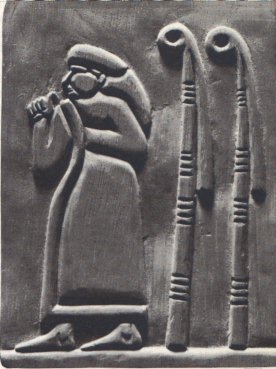
Scene from the top of the Uruk Vase: Inana infront of the
Ringposts at the entrance to E-anna
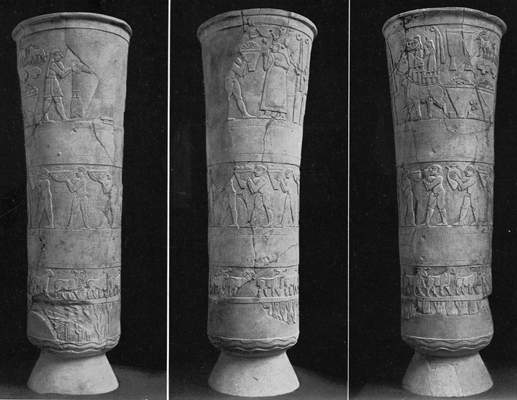
the Uruk vase (for hi-res version go
here)
Jacobsen bases some of his remarks on his interpretation
of a Bridal Song which he call's "Dumuzi's Wedding"
and which is available in large part at the following ETCSL.
From this text he notes Dumuzi's comforting words to Inanna as
part of their courtship; from
another text, Jacobsen interprets the arranging of
a marriage between Dumuzi and Inanna, the central components of
which are the ritual dressing of Inanna in preparation to receive
her loved on at the door, and the opening of the door and receiving
the groom (which was the central act in Sumerian marriage). Inanna
is vocal that the pure bed and all preparations should be arranged
as consummation of the marriage followed immediately after the
door opening.
Jacobsen notices several distinctive parts about this marriage
which he endeavors to answer: First that Inanna's ceremonial ornaments
seem to come out of a heap of Fresh Dates, and Second, that Inanna
states that Dumuzi is to be brought back to that same mound of
dates [after the wedding.] Bearing in mind that the date harvest
was the most important of Uruk's different agricultural incomes,
Jacobsen's explanation is interesting and informative as it lays
bare the original form of a complex goddess and that of her husband
at the same time. He offers the following insight to explain the
text:
About Inanna: Jacobsen says her name was originally Ninanna(k),
which he translates "Lady of the date clusters". He
states she represents the numen of the storehouse for dates, "that
"storehouse of Eanna" which she opens for Dumuzi in
the text. Her emblem -that is to say, her pre-anthropomorphic
form- confirms this, for it is, as Andrae has shown, a gatepost
with rolled up mat to serve as a door, a distinguished mark of
the storehouse."
About Dumuzi: "Correspondingly, the bridegroom,
Amaushumgalana, represents what is to be stored in the storehouse.[his
name translate to] "the one great source of date clusters"
.. Dumuzi-Amaushumgalanna is this a personification of the power
behind the yearly burgeoning of the palm and its producing its
yield of dates; he is, in fact, the power in and behind the date
harvest."
Jacobsen concludes "that these powers are wed means the power
for fertility and yield has been captured by the numen of the
storehouse - and so by the community - and has become its trusty
provider for all time." In other words Dumuzi as personification
of the date yield weds and lies down with Inanna, representing
the storehouse of the E-anna, which fills the land with pleasure
and satisfaction. The author's insight here is very imaginative
and insightful but some caution should be given in regards his
interpretations of these divine names which are not universally
accepted - and in addition the interpretation of the ringposts
(gateposts) of Inanna seem to be a complex matter.
-For some explanations of the importance or E-anna and Uruk in
the Uruk period, please see write up for the previous painting
"Uruk":
-For an idea of the influence and demand for offerings and goods
Uruk asserted over its neighbors, proof of which comes in the
form of seal impressions for example, please see the City
Seal section
About the Ringposts
While the interpretation of the ringpost as a pre-anthropomorphic
form of Inanna seems ideal in some regards, this idea may be complicated
by the realization that the ringpost was hardly the reserve of
Inanna, or of Uruk for that matter: it can be seen in seals and
reliefs depicting various localities and divinities.
Krystyna Szarzynska in her paper on "Archaic
Sumerian Standards" presents a very interesting discussion
on the device commonly referred to as "the Ringpost."
The Ringpost is relevant to her discussion because it was featured
as part of one of the "Archaic Standards" - these were
actual physical objects which priests or cultic personal carried
in their hands, or else that were stationed at the entrance to
cultic or administrative buildings; however, Szarynska also discusses
the ringpost by itself as well, and in this context refers to
it as sign 248 for which she gives a reading of ÛRI (ÛRI3).
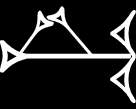
Cuneiform for ÛRI3 from ePSD
She explains "the logogram ÛRI means "care"
or "protection." This meaning could explain the widespread
use of the sign in various places, situations and periods."
As can be seen in the above cuneiform from ePSD, ÛRI3 looks
much like a ringpost, and is used in the writing of the word urin
"guard", "pure", "standard" and
in the writing of urinak which has the meaning "sanctuary."
Szarzynska continues: "The magical or cultic character of
the symbol ÛRI is supported by a small fragment of a stone
model of a temple in Uruk. This artifact has preserved traces
of two poles with loops set at the entrance to the building (fragment
W 16618 from the region of the ziggurat with the "White Temple").
In addition, two ÛRI signs were incised on the sherd of
a cultic vessel from Jemdat Nasr. Finally, a high gate pole with
a loop made of wood and covered with copper plates was found in
Girsu near the temple of Ningirsu from the time of Ur-Nanshe (ca.
2500 BC), and is almost identical with sign 248 [ÛRI]."
The author further notes that as a result from a change of construction
materials from reed stalks to later of wood, the ÛRI device's
took on a more thin appearance - such as when "in the paws
of the dragons represented on the libation vase of Gudea [Gudea's
cup]."
To follow are examples of this device from various
places and periods:
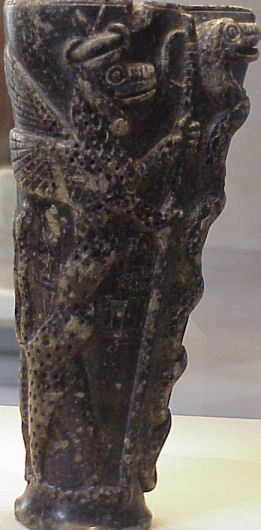
The Mus-hussu (dragon) holds an ÛRI3 on the Gudea Cup
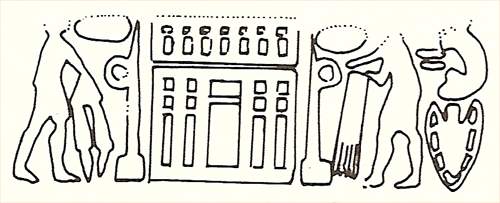
Sampling of some material culture from the area of the Susiana
plains in West Iran
from the late Uruk period: note the ÛRI3
or ringposts (from Algaze work "The Uruk World System.")
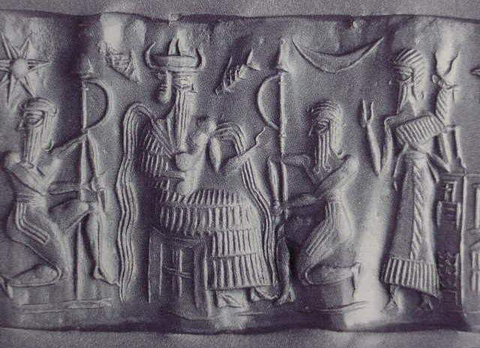
ÛRI3 adorn either side of Enki in this cylinder seal.

In the Akkadian era seal, four hero's each hold an ÛRI3
and kneel below
four divine symbols - perhaps a representation
of four different temples or cities?
Conclusion: While the ring post does feature prominently at the
E-anna, can our understanding of this device and its corresponding
logogram ÛRI3 (used in the writing for words meaning "standard"
or "sanctuary", generally) support Jacobsen's localized
interpretation of a gatepost with rolled up mat which distinguishes
the storehouse? while this may make good sense in the context
of Inanna as embodiment of the storehouse, it seems to make less
sense when the same object is held by the Mus-hussu, or carried
around by the Hero's. The gatepole from the temple of Ningirsu
had wooden loops with copper plating - these were not roled up
mats. Because the importance of the early importance of Uruk as
what might be termed the first truly administrative Sumerian city,
we might see this device as having its true significance there
at E-anna, and the wider use and definition of the object as a
secondary development; this however is conjectural as of the moment.
|






